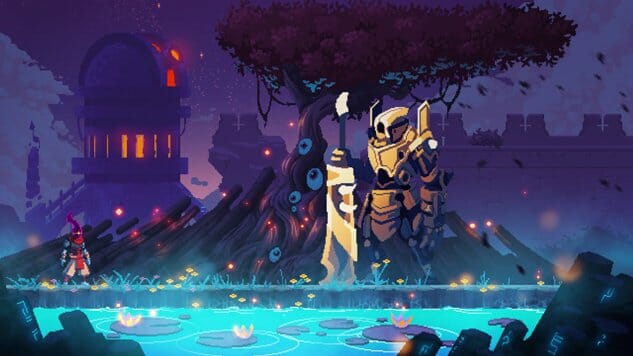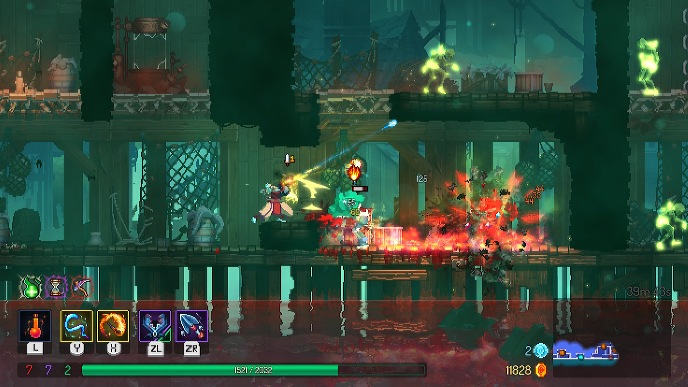
Dead Cells combines two genres that simply shouldn’t mesh. The roguelike is marked by randomly generated levels that change with every play and the permanent loss of any items the player has accrued when they die. The Metroid-style platformer has the player regularly retrace their steps through a sprawling world after acquiring a series of permanent new abilities that unlock previously inaccessible areas. The two are fundamentally at odds with each other.
A crucial part of games like Metroid and Castlevania: Symphony of the Night is remembering where to go and how to get there, which literally isn’t possible to do in a game that changes every time you play it. Also those games make a pact with the player that, when they find a new ability, they’ll have it permanently from that point on (although sometimes there’s an exception for specific weapons, like the guns in the original Metroid.) Compare that to Spelunky, an archetypal roguelike platformer: when the player dies they start over from scratch, without most of the power-ups they might have found or purchased in their last game. Every game in a roguelike is a fresh start that’s entirely self-contained, whereas Metroids and their ilk present a single, unbroken adventure that will take many hours and several different play sessions to complete.
Dead Cells wants to bring these two diametrically opposed approaches to game design together. Although the seams are readily visible in many ways, with a number of compromises and cut corners making that goal more practical, Dead Cells largely pulls off what should probably be impossible. It captures the spirit of both styles of game, in the process establishing its own unique space beneath the larger umbrella of the platformer.
Here’s how it works: Dead Cells starts the player off in the same space every time they start a new game. They proceed through the same first level, which consists of a variety of tunnels and shafts that resemble side-scrolling Metroid and Castlevania games, and that branch off of each other in a new arrangement every time. In a riff from Dark Souls, another game that basically inspired its own genre, they collect souls from the enemies they defeat, which act as a currency to unlock permanent new abilities. If the player dies at any point, they lose the souls they’ve collected, and whatever new weapons or items they’ve come across during that play session, and are reborn at the same opening area they begin every game at. Then it begins anew, with a new layout every time.

This might sound like the Metroid connection is incidental—that it’s based simply on both games being 2D sidescrollers. Dead Cells makes a stab at backtracking by introducing various abilities that are unlocked deeper into the game, but that can be used to get to areas that can be seen but not reached from the very first level. These abilities are permanent—they don’t go away when the player dies. That’s one of the compromises the game has to make to pull off its goals; instead of true permadeath, with every perk and item disappearing, there are certain upgrades that persist from game to game once they’re acquired. And that’s how the Metroid-style structure becomes possible in an always-changing world.
All of this discussion about genre traits recedes into the background when Dead Cells is actually being played. There’s little time to think about such matters when there are enemies everywhere to be killed. In another nod to the Souls games, Dead Cells boasts a style of combat that can quickly fell a player if they don’t proceed carefully. It isn’t nearly as punitive as those games, and the relatively small variety of foes makes it far easier to memorize patterns and react accordingly on the fly. Still, death can come quickly when the player isn’t careful, especially early on, before they’ve had a chance to boost their health bar. With two main weapon slots that can be devoted to a variety of swords, bows, shields and whips, and two alternate slots for grenades, turrets and traps, there’s a small arsenal at the player’s disposal, and cycling through those options in the heat of battle will make it impossible to dwell on design matters. The physical satisfaction of juggling the game’s various demands will take precedence.
It’s mechanically sound, but the aesthetic merits some reconsideration. It’s set in a decaying miasma that seems overly familiar in this era of dying and diseased game worlds. The character’s ability to regenerate inspires the game’s title; a corpse is regularly reanimated by a slurry of genetic material and sent back out to die again, a collection of constantly dying cells rejuvenated by an infusion of more dying cells. This world is so dead that its only hope is a reanimated corpse, the game seems to say. The environments and overall art design lack the inspiration of the game’s action, even if the actual character designs are alluringly grotesque.
Not content with sheer novelty, Dead Cells importantly taps into the most significant aspect of both of the genres it fuses together. Few games are as addictive as those Metroid-style backtrackers, and perhaps the only thing that has come close this decade is the spate of roguelike platformers that flourished in Spelunky’s wake. Dead Cells beautifully captures what makes both of those genres impossible to put down, uniting the “just one more” drive of a roguelike with the “must keep going” compulsion of a Metroid. It’s a smart, confident piece of work that works perfectly with the Switch’s portability, and anybody interested in either of the genres it builds on should consider checking it out.
Dead Cells was developed and published by Motion Twin. Our review is based on the Switch version. It is also available for PC, PlayStation 4, Xbox One, Mac and Linux.
Garrett Martin edits Paste’s comedy and games sections and also writes about theme parks. He’s on Twitter @grmartin.